A Brief History of Bishop’s Falls
Back to Blog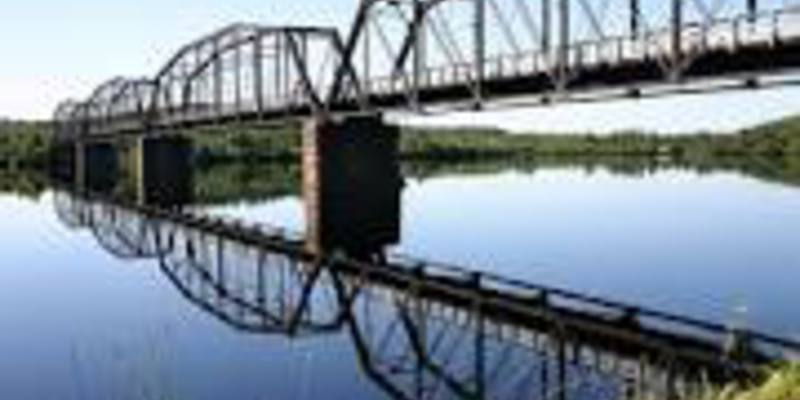
In the beginning . . .
In 1827, Bishop John Inglis, Anglican Bishop of Nova Scotia and Newfoundland, was on a visit to the colony of Newfoundland where he consecrated churches from Notre Dame Bay to Placentia Bay. In July, he visited Exploits Island in Notre Dame Bay. He, along with a “Mr. John Peyton” made a journey inland along the route of the Exploits River, where Mr. Peyton had established several salmon stations. Rev. Edward Wix also accompanied the men as they sailed from Exploits Island up the river for a distance of approximately 25 miles, and landed at a spot which the Bishop described in his journal as having a splendid waterfall, good land, finely wooded with large timber and a rich picturesque.
In honour of the Anglican prelate’s visit, the waterfall was thereafter called the Bishop’s Falls. From that time until 1893, little is known of any development in the area, except that Harry Crowe operated a lumber operation out of “Botwoodville” during the time and probably conducted some logging along the banks of the river.

In 1893, with the coming of the railway, the first attempts to span the river with a bridge were made by construction crews of the Newfoundland Railway. It would take three attempts before a successful trestle crossing was established in 1900-01 further upstream from the falls. The first trestles were built of wood with wooden abutments and all got washed away. The new steel trestle with granite abutments spanned 927 feet and was quite an accomplishment in its day. The last train to use the rails was on September 30, 1988.
The rail bed now devoid of its steel rails and rail road ties which were all removed by the end November,1990 is now used as an ATV and snowmobile trail.
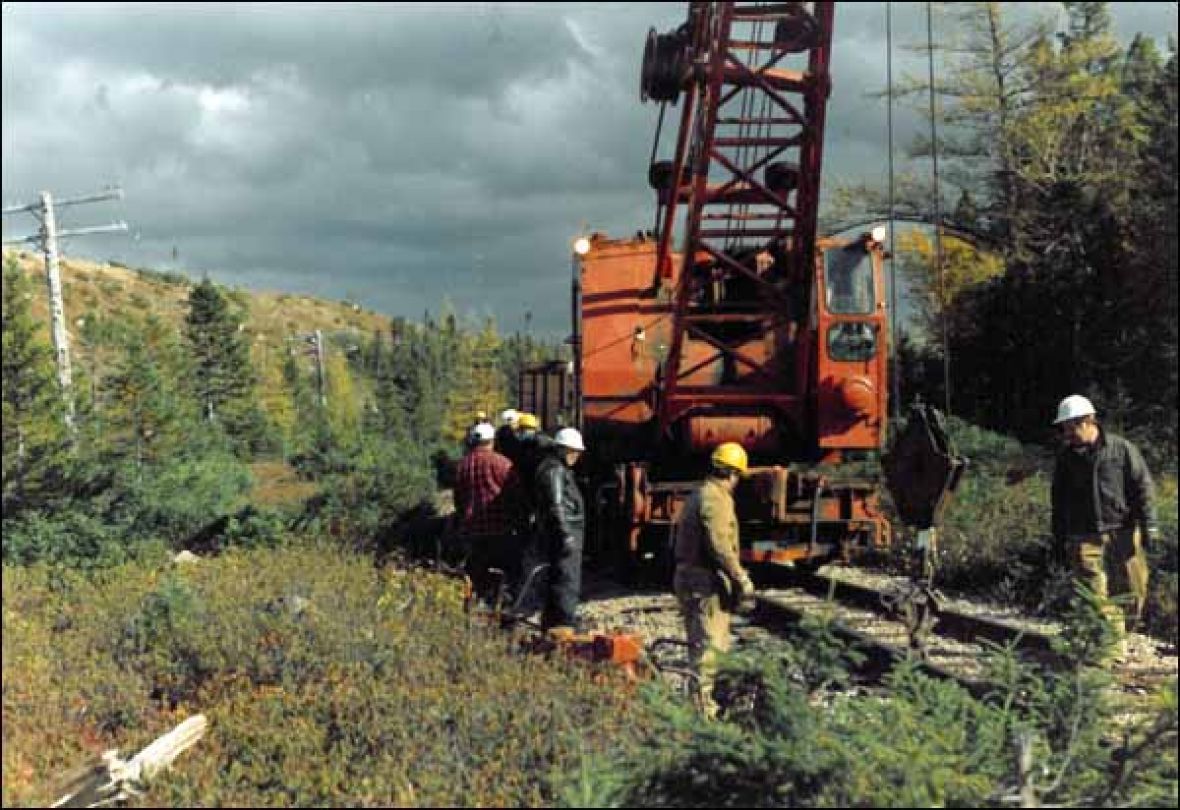
The census of Newfoundland for 1901 showed a population of 20 persons located at Bishop’s Falls. More than likely, their occupations were connected with the railway. In 1908, survey work on the site for the ground wood mill began in earnest. Construction of a pulp mill began in 1909, and a townsite started to take shape, with the workers establishing living quarters in an area commonly known as “The Plant”.
The mill opened in 1911, and with further developments ten miles upstream at Grand Falls, the future growth of Bishop’s Falls as a town was assured. By this time, the population had now increased to 343.
The Albert E. Reed Ground wood Pulp Mill
Albert Edward Reed, major principal of A.E. Reed and Co., which owned five paper mills in Britain, expressed an interest in establishing a mill in Newfoundland in 1905. However, original plans to establish a mill in Bishop’s Falls collapsed, but Reed continued negotiations with Harry Crowe, who held the timber rights in the area, and with the Newfoundland government for power rights on the Exploits River in Bishop’s Falls. In the spring of 1907, after engineering surveys and negotiations were complete, a mill was constructed in the area where Crowe’s company had been located. The Reed Company procured power rights at the falls from the Newfoundland government, and a dam was constructed in 1908, while the site work for the mill was being prepared.
After the mill opened in 1911 for operations, ground wood pulp produced at the mill was shipped by rail to Botwood and on to England. Output was 130 tons of ground wood per day. A.E. Harris was appointed manager, a position he held for the life of the company, which was 13 years. In 1923, the mill was sold to the Anglo-Newfoundland Development Co. Ltd. The employees of the mill worked 7-day weeks in the beginning. The wages were low by today’s standards at 22 cents per hour before World War I, and only 25 cents per hour by 1920. 500 men lived and worked in the area, many living in a site not far removed from the mill, known locally as “Shacktown”. The town had only one mile of road in those days, from the station to the plant.
The entire operation closed at the end of March 2009 due to an inadequate costly wood supply, antiquated equipment and high operating costs. 450 mill workers and 300 forestry personel recieved layoff notices. The buildings remained remained onsite until final demolition was completed in 2017.
Logging Operations
The first logging operations carried out in the interior of Newfoundland were firmly established long before the pulp and paper mills were built. Millertown has been established in the 19th century, as had Bo Woodville (now Botwood). After the two mills were established, four main divisions of logging operations were headquartered at Millertown, Badger, Bishop’s Falls and Terra Nova. The Bishop’s Falls division operated largely in the Great Rattling Brook region, accessible initially from the town itself, and, in later years, from Jumper’s Brook just east of the community. By the mid 1930’s, because of acquisition of the Bishop’s Falls mill and increased production in Grand Falls, half of the wood could be floated to the mills at Bishop’s Falls and Grand Falls, using the Exploits River and its many tributaries and streams.
Logging operations were primarily a contractual arrangement between the mill management and a number of local contractors who established camps at strategic sites in the interior. Amos Feener, Pat Lahey, Theophilus “T” Stuckless and Pierce Penton are names synonymous with early constructors. Living conditions in the woods camps were harsh, but there was never a shortage of willing workers. Many came from the bays and coves of Notre Dame Bay and eventually resettled in the central towns.
The logging operations of the Great Rattling Brook, known as “The Line”, reached extensively into the interior with a large base camp at an area commonly known as “The Depot” (site of Lions Max Simms Memorial Camp today), with names such as “{Pat Lahey’s Camps” or “Amos Feener’s Camps.” Roads built to these camps later on still bear the names of these contractors.
Grand Falls Central Railway
The A.E. Reed Company utilized two railways to the benefit of the mill in Bishop’s Falls. Firstly, a spur leading from the main line and yard at Bishop’s Falls was used extensively during the construction phase of the mill. Although not used as much after, the spur was maintained for many years. Secondly, the A.N.D. (Anglo Newfoundland Development) Company has built their own railroad from Botwood to Grand Falls, the site of their paper mill, around 1908-09. A line was built from the Reed ground wood pulp mill at Bishop’s Falls connecting this line, following successful negotiation the A.N.D. Company. As a result, Botwood grew significantly with a railway tie 22 miles long between the Central Newfoundland towns. Supplies and cargo brought to the company from around the world, was shipped to Botwood and then railed to the mill at Grand Falls. Later, when the mine at Buchans began producing ore, the shipments were brought to Bishop’s Falls by the Newfoundland Railway and transferred to the A.N.D. Company line for rail shipment to Botwood. A late passenger service was instituted between Grand Falls and Botwood with Bishop’s Falls in the middle.
The Pipeline
In 1923, following the purchase of the Reed operation in Bishop’s Falls, a new road was constructed by the A.N.D. Company, linking Grand Falls with Botwood through Bishop’s Falls. Additional power was obtained from Bishop’s Falls operations, and plans were made to construct a 20-in diameter pipeline nine miles long to pump the pulp produced in Bishop’s Falls to the mill in Grand Falls, where it was to be made into paper. The pipeline was finished in 1924 and immediately went into operation. Amazingly, this pipeline was constructed practically by hand with picks and shovels.
Following the takeover of the Bishop’s Falls operations, A.E. Harris was retained as manager of the mill, and later became manager of the Grand Falls operation until his retirement in 1929. Harris left an impressive collection of etchings and water colours of Newfoundland as it appeared in the early part of the 20th century. Many of these scenes remain in and around Bishop’s Falls.
Red Indian Lake Dam and Other Developments
Throughout the latter part of the 1920s, many modifications were made to both mills to improve operations. A new concrete and steel dam was erected at Red Indian Lake, which increased efficiency of power production during low water periods. Increased power production in 1928 was used to supply operations in Botwood, which by now was the export port for newsprint and ore mined at Buchans. A transmission line was constructed between Grand Falls and Bishop’s Falls in 1929. Power now being generated at Bishop’s Falls was supplying the mill and power for Grand Falls and Botwood operations. Other improvements in the 1930s were made to the Bishop’s Falls mill which allowed it to reach a peak of 205 tons of ground wood being produced per day, along with improved quality through modernization.
The Depression Era
Newsprint prices fell in the 1930s, and wages at the mill were reduced. However, as many as 1600 men were employed through the woods operations, with wood being cut from July to December, and winter hauling following. The mills still turned a profit in 1933. A contract to haul newsprint to St. John’s for ten years was a boost for the area. The remainder of the 1930s saw continued growth and efficiency although profits were reduced due to fluctuating world prices. But, overall, both operations emerged successfully as the Second World War began. During the war, a reduction in exports of newsprint to England, but new markets were opening in Central and South America. However, a shortage of labour brought on by the men enlisting to assist in the war effort overseas, caused the mills to run on less than full capacity.
Decline and Closure of Bishop’s Falls Mill
After the war ended, a shadow began to loom over the operations of the ground wood at Bishop’s Falls. With improvements and installation of four additional pocket grinders to the mill’s operation in Grand Falls, the mill was able to achieve a monthly record of 650 tons per day. Plans were made to modernize the Grand Falls mill and convert the Bishop’s Falls operation into a hydro-electric power station. The pipeline connecting the two mills wasn’t needed any more and other factors were pointing to the eventual end of the mill as a production facility. Ground wood pulp operations ceased in 1951. It would take two more years before dismantling of the facilities was completed. Thereafter, the Bishop’s Falls power plant continued to be the last significant part of the operation remaining that had helped found the community.
The mill lay derelict and neglected over the years. By the 1970s, the building had deteriorated to the point where the company took security steps to prevent entry. Only the power plant was accessible, and only to company employees. The generation of the post war years knew little of its significance to the life of the community.
The above was written by George Saunders: Author of "In the centre of the forest...I remain"
The highway
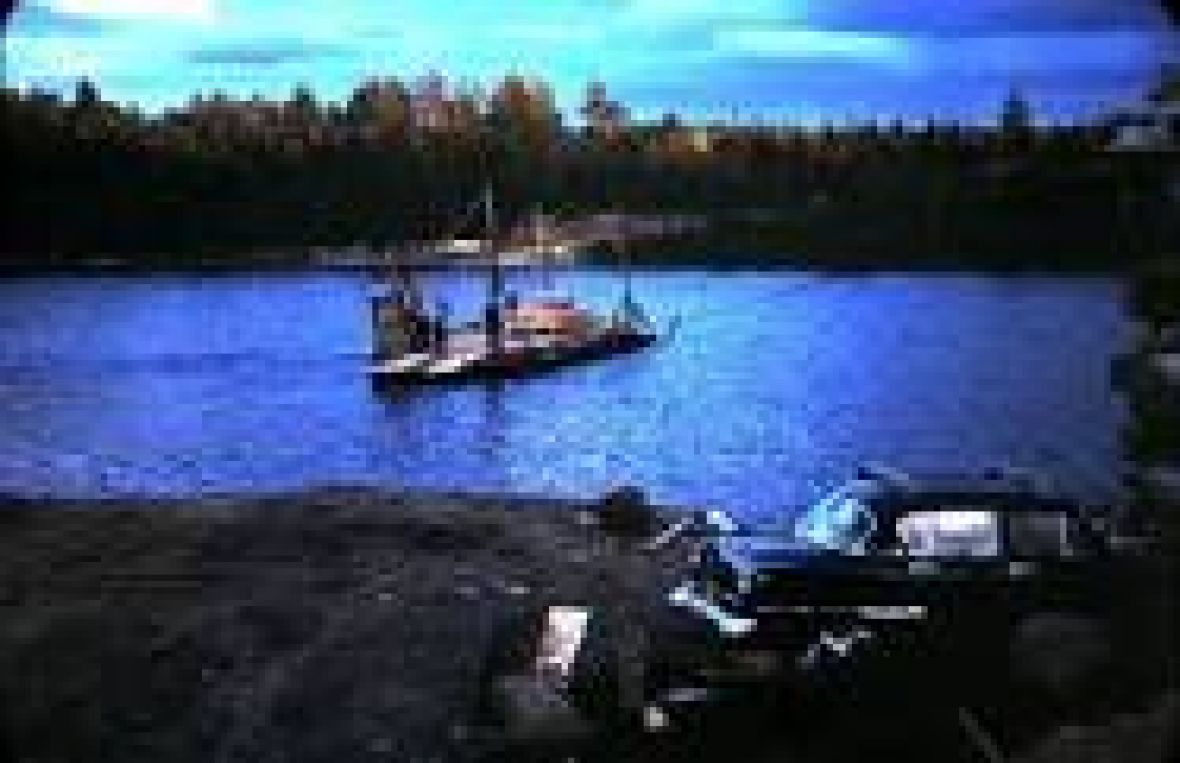
The contract to put the first road across the island of Newfoundland was signed on may 16, 1893. At the time of building it was a gravel road only and was to connect the capitol St. Johns on the east coast with Port Aux Basques on the west coast. However, there were major rivers to contend with along its route with one of the largest at Bishop's Falls named the Exploits River. At this location a local resident named Joe Hampton built and operated a "ferry" consisting of a wooden platform attached to oil drums( the scow it was often referred to as ). It used a motor boat complete with a car engine for propulsion and it was all fixed to a cable spanning the river. It could carry four vehicles at one time. Travelling the road was always risky at first as quite often during periods of rain washouts would occur along its route leaving motorists stranded. It was described by one of its first travellers as "an endless succession of iron-surfaced washboard, gaping pot holes, and naked rock---a shoulder twisting, neck snapping dust shrouded horror" The Newfoundlland section of the Trans Canada Highway was paved in 1965.
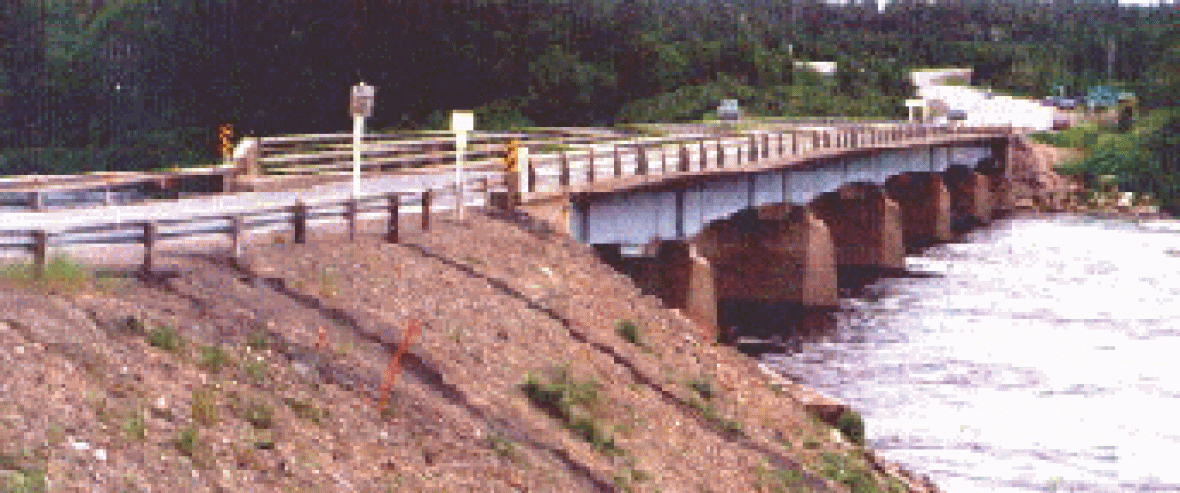
It was not until July 2, 1954 that construction began on the 600 foot five piered Sir Robert Bond bridge that now crosses the Exploits river and eliminating the need for Hampton's ferry. The project was finished on July 2, 1958, four years to the day. Due to its narrow width the bridge was never meant for transport trucks so in 2014 construction began on a new bridge adjacent to the old one, down river that will carry all traffic going west. The Sir Robert Bond bridge will still carry traffic east.
The Flood of 1983
On January 14, 1983, some of the worst flood damage ever recorded in Newfoundland occurred, thanks to the Exploits River on whose northern bank sits the Town Of Bishop's Falls. According to the Department of Environment and Conservation, Water Resources Division, exceptional rain fell on an above average snow-pack, and following several days of above-freezing temperatures resulting in a flood of water never witnessed in the area before.
The main damage was through bank erosion, and three houses located on Circular Road were swept away as well as most of the road itself along the rivers edge. A local Lions Club community center, a senior’s complex, and a recently-constructed riverside park containing several railway cars were also lost. However the river also claimed the “powerhouse” or hydroelectric generating facility owned and operated by Abitibi Price who operated a pulp mill in the area. The plant provided electricity to its shipping warehouse in the nearby community of Botwood but more importantly to its pulp mill located in Grand Falls. Many other houses were left in an unsafe position, and flood damage in total was estimated at $3 million. The area had no history of flooding prior to this date.
The flood saw a deluge of 200 millimetres of rainfall; the river current surged from 6,000 cubic feet per metre to 90,000 cubic feet per metre. Following the disaster, an additional number of flood gates were installed as part of the reconstruction of the power plant. It was thought that the inability of the personnel at the generating facility to open all of the flood gates within the dam on the river contributed to the disaster. The facility was originally built in 1907.
In view of hundreds of amazed watchers, two 60-tonne old railroad passenger cars on the park site locally known as "The Bark" were tumbled about like dinky toys until they sank out of sight in the river. Approximately 110 families were evacuated from homes along the riverbank. Parts of the washed-away Lions Club built on the same site were later found in Botwood and Peterview two communities approximately 10 miles downstream that lay along the shores of Notre Dame Bay. The railway cars were never found.
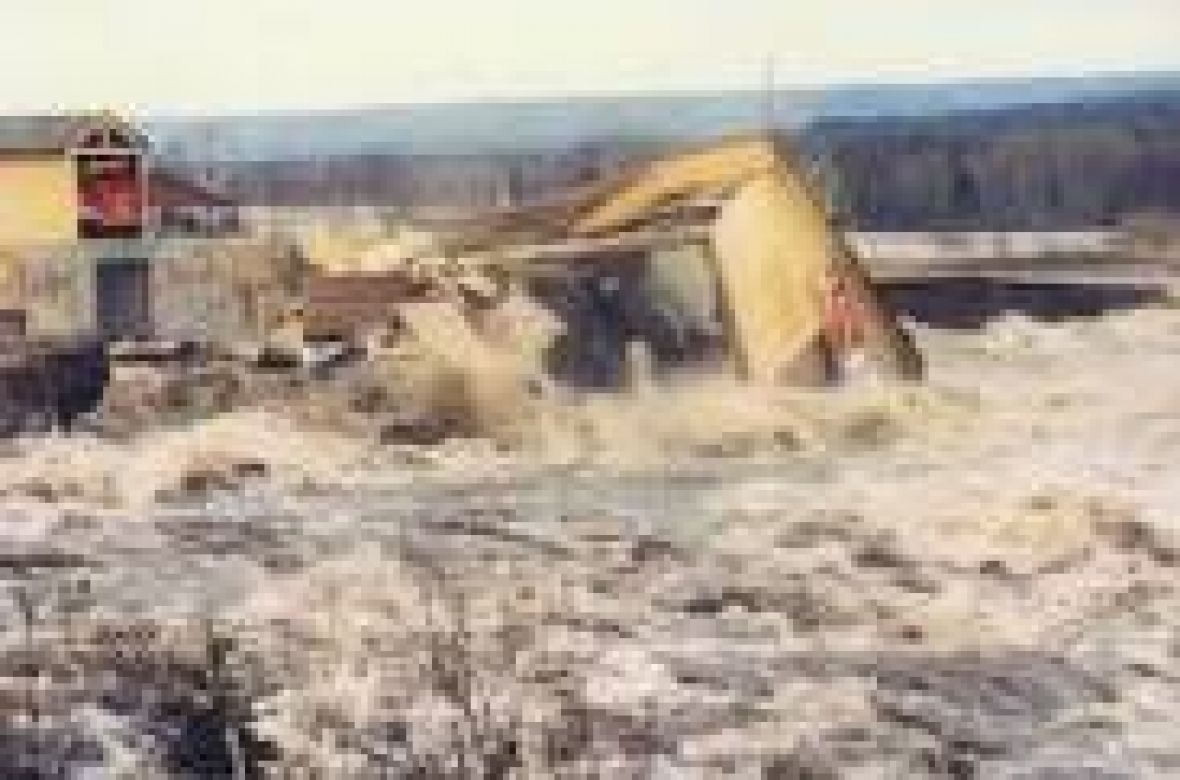
There was no loss of life during the actual flood but one local resident loss his life during the reconstruction phase of the dam and hydroelectric plant when a boat he was in capsized in the freezing river. Another passenger in the boat who was working with him at the time and also thrown into the river miraculously survived.
A video of the actual flood can be viewed at:
https://www.facebook.com/NewfoundlandFilmAndPhoto/videos/1022642857802074/
To see the new hydroelectric power plant please visit:www.youtube.com/watch?v=Hg47VmBmw0c



